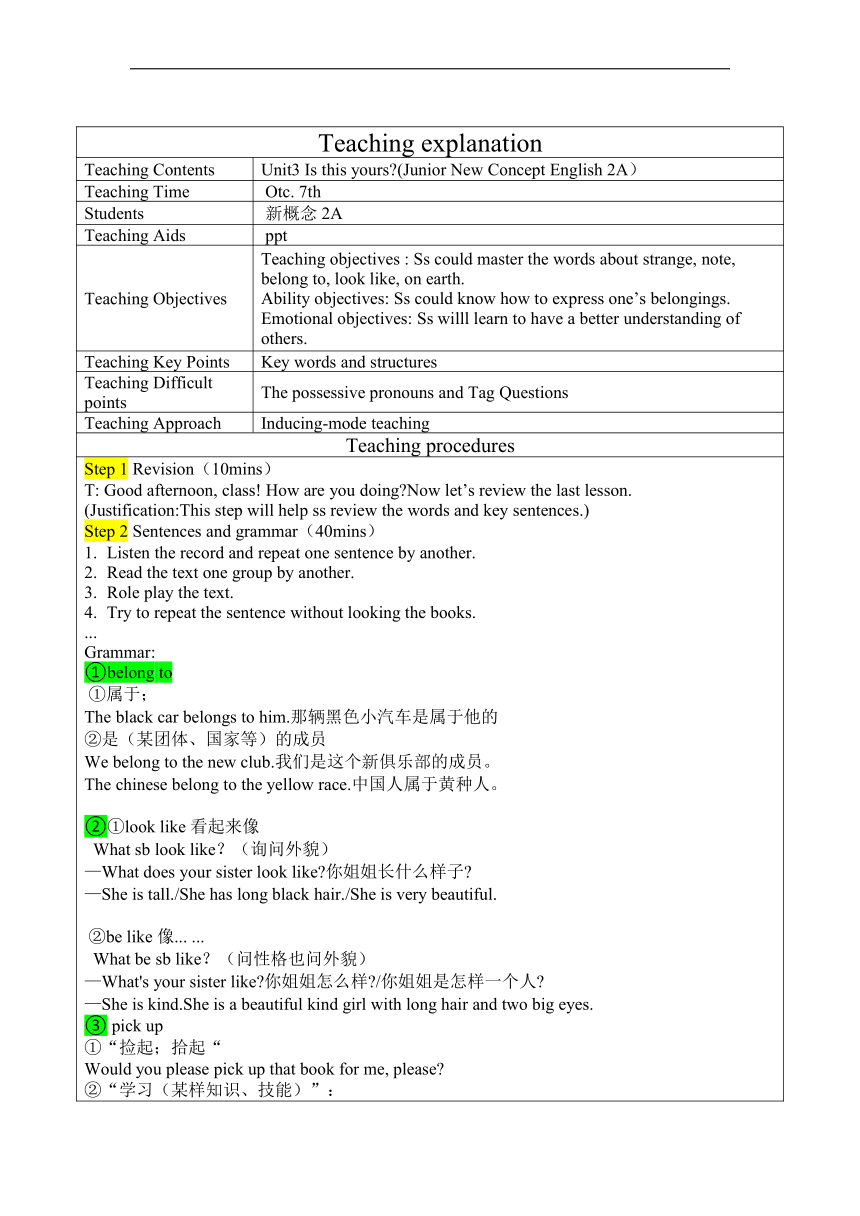
Teaching explanation Teaching Contents Unit3 Is this yours?(Junior New Concept English 2A) Teaching Time Otc. 7th Students 新概念2A Teaching Aids ppt Teaching Objectives Teaching objectives : Ss could master the words about strange, note, belong to, look like, on earth. Ability objectives: Ss could know how to express one’s belongings. Emotional objectives: Ss willl learn to have a better understanding of others. Teaching Key Points Key words and structures Teaching Difficult points The possessive pronouns and Tag Questions Teaching Approach Inducing-mode teaching Teaching procedures Step 1 Revision(10mins) T: Good afternoon, class! How are you doing?Now let’s review the last lesson. (Justification:This step will help ss review the words and key sentences.) Step 2 Sentences and grammar(40mins) Listen the record and repeat one sentence by another. Read the text one group by another. Role play the text. Try to repeat the sentence without looking the books. ... Grammar: ①belong to ①属于; The black car belongs to him.那辆黑色小汽车是属于他的 ②是(某团体、国家等)的成员 We belong to the new club.我们是这个新俱乐部的成员。 The chinese belong to the yellow race.中国人属于黄种人。 ②①look like 看起来像 What sb look like?(询问外貌) —What does your sister look like?你姐姐长什么样子? —She is tall./She has long black hair./She is very beautiful. ②be like 像... ... What be sb like?(问性格也问外貌) —What's your sister like?你姐姐怎么样?/你姐姐是怎样一个人? —She is kind.She is a beautiful kind girl with long hair and two big eyes. ③ pick up ①“捡起;拾起“ Would you please pick up that book for me, please? ②“学习(某样知识、技能)”: I picked up some Japanese when I was visiting Japan. ③“用车接某人”:pick sb up/pick up sb (若为代词放中间) I’ll come by your house at 6 o’clock and pick you up. Paul will pick Claire up at school. ④give 给 give sth to sb=give sb sth 把某物给某人,给某人某物 Would you please give me a piece of paper? 能给我一张纸吗? He gave his books to the school.他把他的藏书捐赠给了学校。 ⑤Tag Questions反意疑问句 一、定义 当我们陈述了一个事实,而又不是很有把握,就可以在陈述句后加一个简短问句,称为反意疑问句。 1. She is a student, isn’t she? 2. We speak Chinese, don’t we? 3. The note isn't Dasiy's, is it? 二、结构 1.陈述部分肯定句+疑问部分否定句(可记为前肯后否)。 They work hard, don’t they? 他们努力工作,不是吗? She is a student, isn’t she? 她是一名学生,不是吗? 2.陈述部分否定句+疑问部分肯定句(可记为前否后肯)。 You're not a teacher, are you? 你不是一名老师,是吗? The note doesn't belong to Paul, does it? 这个便条不是保罗的,是吗? 三、回答 (根据事实从后往前翻译) 1.陈述部分肯定句+疑问部分否定句(可记为前肯后否)。 They work hard, don’t they? 他们努力工作,不是吗? Yes, they do.对,他们工作努力。/No, they don't.不,他们工作不努力 She is a student, isn’t she? 她是一名学生,不是吗? 2.陈述部分否定句+疑问部分肯定句(可记为前否后肯)。 You're not a teacher, are you? 你不是一名老师,是吗? Yes,I am. ... ...
~~ 您好,已阅读到文档的结尾了 ~~